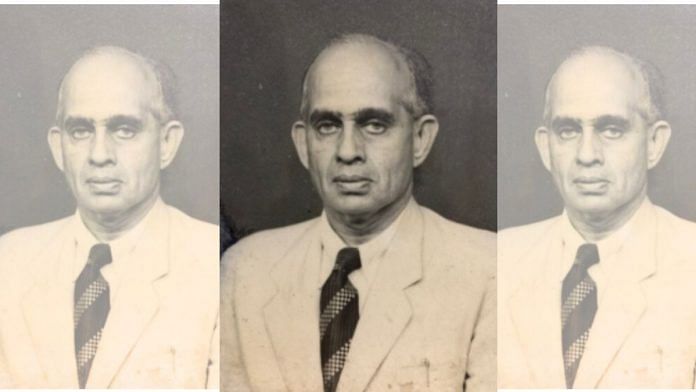Thank you dear subscribers, we are overwhelmed with your response.
Your Turn is a unique section from ThePrint featuring points of view from its subscribers. If you are a subscriber, have a point of view, please send it to us. If not, do subscribe here: https://theprint.in/subscribe/
80 years ago, my wife’s grandfather enlisted for World War 2 and set sail for North Africa. It was early 1943, when Colonel Dr. D.S. Iyer, arrived in Cairo. A legendary general surgeon in Madras (now Chennai), in the south of India, he took the bold step of leaving behind his young family of 5 in joining the war-effort in Africa and Europe to help defeat the Nazis and the Italian fascists.
Colonel Dr. Iyer, was attached to the medical core of the 4th. Infantry Division of the British Indian Army (see map below). The Ruweisat Ridge was where the 4th. Indian Army faced the fearsome German Panzer Tank and the Italian 25th. Division, as part of the Second Battle of El-Alamein in Egypt. This battle was a milestone in the North African campaign in World War 2 as it resulted in the first major defeat of the German Afrika Korps. The 4th. Indian Army continued their long North African campaign into Tunisia before eventually defeating the Germans and Italians once and for all, thus
ending the war in North Africa by the summer of 1943. For Colonel Dr. Iyer, post the North African Tunisian campaign, it would be another 2 years before he would see his beloved family again.
In January 1944, Colonel Dr. Iyer crossed into Italy via Sicily to face the Germans in what would be one of the bloodiest battles of the European campaign in World War 2, the Battle of Monte Cassino (see map below). The 4th. Indian Division was under the larger command of the Eight Army of the Allied Forces. From whatever I could stitch of his experience in North Africa and Italy, as narrated by his daughter, Shantha (now aged 92), Dr Iyer was constantly in the trenches, operating on bloodied Indian, British, and American soldiers as they came in droves, severely wounded by heavy German artillery shelling from atop the monastery of Monte Cassino. At many a time, he had to cauterize his surgical instruments in makeshift equipment built from cut open and used gasoline tanks, filled with nothing other than boiling water and some alcohol.
Over the next 4 to 5 months of pitched battles, Dr Iyer had to, on numerous occasions, operate during German bombardment without any anaesthetics while attempting to save the lives of Allied troops. Though primarily a surgeon, his duties extended into night duty patrol of the trenches with a pistol in his pocket in case of any surprise German attacks! To cope with the extreme stress of continuous bombardment, performing surgeries while having to frequently shift locations in the middle of an operation owing to mortar and artillery fire, Dr Iyer developed a chain-smoking habit, something that eventually resulted in India losing one of her finest surgeons to a heart-attack in 1960. At Monte Cassino, Dr Iyer met with King George of England at the end of the battle as his Excellency provided a morale boosting trip to visit Allied troopsin Italy in mid-1944. Unfortunately letters of correspondence between Dr Iyer and the friends he made with British and American troops during the war, thanking him for his contributions have been lost over the decades.
In May 1944 the Germans were defeated at Monte Cassino, and the Allied troops consisting of the British Indian Army moved ahead beyond the Gustav and Adolf Hitler lines onwards to Rome and then
to the Gothic Line close to Pisa (famous for the leaning tower). With victory in Italy in sight, Colonel Dr Iyer and the 4th Indian Army were shipped to Greece at the end of 1944 for much needed rest, and eventually he made his way back home to India in the summer of 1945, with Europe freed from the Nazis. Unknown to Dr Iyer, his family had moved location during the war owing to the Japanese bombing his city of Madras in the summer of 1943, while he was in North Africa; however, that by no means tempered a joyous reunion and welcome to the family’s war hero.
The 4th. British Indian Army that Colonel Iyer served in suffered 25,000 casualties, while capturing over 150,000 German/Italian troops and won over 1,000 honours including 4 Victoria Crosses. In the words of Field Marshal Lord Wavel (who became Viceroy of India till Independence), “…. The fame of this Division will surely go down as one of the greatest fighting formations in military history ……”. The Indian Army deserves credit for crushing the Italian Army in East Africa and defeating the much vaunted German Wehrmacht in Tunisia and Italy.
This short story of Colonel Dr Iyer in the Mediterranean is a tribute to a man whom I never met, but nevertheless respect immensely for his commitment towards a higher duty and purpose in life. It is in equal if not greater measure a tribute to the contributions of the Indian Army in World War 2, with the recent memorial to the Indian Army at Monte Cassino a fitting tribute to the 5,782 Indian soldiers who lost their life there. With much respect from your grandson-in-law who wishes he could have met you and who is inspired by your call to a greater purpose. Thank you for your contribution to make the world a better place in fighting against fascism, intolerance, and injustice.
These pieces are being published as they have been received – they have not been edited/fact-checked by ThePrint.

